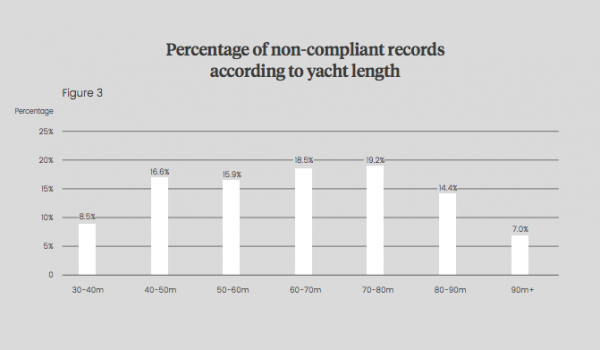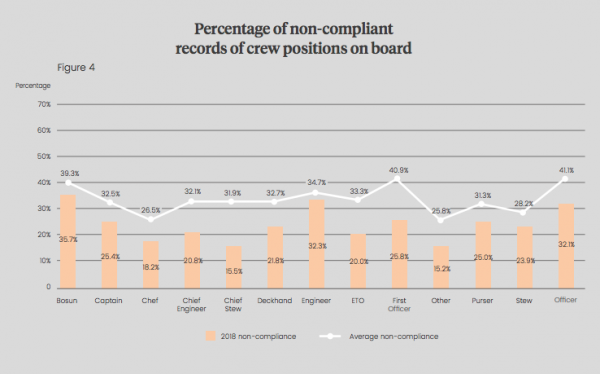Compliance around the clock
The Superyacht Report examines hours of work and rest data recorded by crew via workrest software…
Under the Maritime Labour Convention, 2006 (MLC), every flag state must establish either maximum hours of work or minimum hours of rest over given periods that are consistent with the requirements specified by Regulation 2.3. These requirements dictate that maximum hours of work shall not exceed 14 hours in any 24-hour period and 72 hours in any seven-day period, or minimum hours of rest shall not be less than 10 hours in any 24-hour period and 77 hours in any seven-day period.
Since the ratification of the MLC, these requirements have come under the spotlight due to concerns about their practicality for the superyacht industry, where owners and guests expect round-the-clock service. Although crew welfare and safe operation are at the heart of these requirements – fatigue is one of the most common causes of accidents in the maritime world – they have been met with resistance, and many captains are of the opinion that it is impossible to comply. However, as yet, there has been no substantial evidence to establish whether or not the superyacht industry is struggling to comply.
Workrest, a recently launched digital solution designed to log crew working hours and monitor compliance with the hours of work and rest requirements set out by the MLC, has provided a fully anonymous data set based on the records of 707 crew on board different yachts between May 2017 and March 2018 – a total of 45 weeks. These records offer the first insight into how many hours crew employed on MLC-compliant yachts are working and whether the requirements are being met. In the following preview of the analysis, we show how non-compliance is affected by yacht length and crew position.
The workrest platform has a function that records occurrences of non-compliance whenever a crewmember’s hours of work and rest records do not fall within the requirements. The figure below shows the percentage of non-compliant records according to yacht length. Superyachts in the 40m to 90m size range have the highest percentage of non-compliance and those under 40m and over 90m have the lowest percentage of non-compliant records.
 Data provided by workrest
Data provided by workrest
For yachts over 90m, this could be explained by a much larger crew but a similar number of guests compared to a smaller-sized yacht. With a higher ratio of crew to guests, therefore, it’s much easier to meet the MLC requirements. However, it would be expected that it would be most difficult to comply for yachts under 40m, due to a lower ratio of crew to guests. The explanation for this could be that yachts below 40m often have a less demanding charter programme – when instances of non-compliance are most frequent – due to the number of guests they can typically host.
The percentage of non-compliant records for each individual position on board is high, as seen in the figure below, with some positions having more than 50 per cent non-compliance. It is worth noting that non-compliance was much higher on average compared to 2018 alone. This could be because the records prior to 2018 include the Mediterranean summer season, which is famously busy for charters and so is likely to see crew working much longer hours.
 Data provided by workrest
Data provided by workrest
When comparing the percentages of non-compliance over the various crew positions, most fall under the average of 35 per cent. The positions with higher than average percentages are the bosun, officer and first officer roles, which suggests higher pressure for the management positions in the deck department. This is interesting because the deck is not typically thought of as the busiest department when on charter, therefore perhaps this reflects the pressure to work long hours on maintenance and repair when guests aren’t on board. It could also be explained by a timekeeping problem in this particular department and also by a lack of awareness of the requirements.
Many in the industry still report that yachts put pressure on crew to adjust and falsify hours of work and hours of rest forms to satisfy management companies and ensure compliance with the regulations. Therefore, in light of this, the aforementioned data should not be taken as a true representation of the number of hours worked by crew across the industry.
It is also worth noting that this data is solely from yachts using the workrest platform; just by using the digital solution shows a willingness and desire to achieve compliance, so there will be many other yachts that would not be complying as much as the yachts and crew in this data set. This means the results may be limited to some extent in showing a true representation of the number of hours worked by crew across the industry.
That said, this data is unlike anything yet analysed in the superyacht industry and still offers a helpful insight into how crew and yachts are coping with the MLC requirements. While the average number of hours worked by crew during the measured period falls well within the requirements, the percentage of non-compliant records is fairly high for all positions and size of yachts. If a Port State Control inspection were to take place, the officers would not look at the average hours per week worked over the course of a number of months but at the number of non-compliant records in recent times, meaning these results should be cause for concern. It appears that the industry still has a way to go to achieving full compliance with the requirements.
The full data set and analysis appears in Issue 187 of The Superyacht Report. Subscribe here.
Profile links
Click here to become part of The Superyacht Group community, and join us in our mission to make this industry accessible to all, and prosperous for the long-term. We are offering access to the superyacht industry’s most comprehensive and longstanding archive of business-critical information, as well as a comprehensive, real-time superyacht fleet database, for just £10 per month, because we are One Industry with One Mission. Sign up here.



